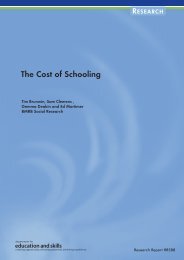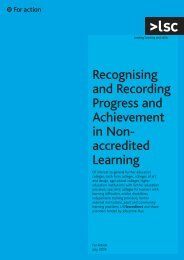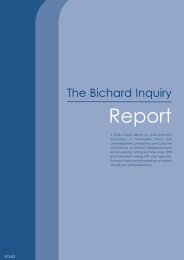Faiths and further education - Church of England
Faiths and further education - Church of England
Faiths and further education - Church of England
- No tags were found...
You also want an ePaper? Increase the reach of your titles
YUMPU automatically turns print PDFs into web optimized ePapers that Google loves.
21The student’s interaction with others <strong>and</strong> the chaplaincy58Some <strong>of</strong> the day-to-day consequences <strong>of</strong> these differentapproaches are clear.Those who interact with students, those whobecome their friend, talk with them <strong>and</strong> try to support themthrough difficulties cannot always confidently predict the form thatinteraction will take <strong>and</strong> the vocabulary used. In the widest sense,those within the chaplaincy, be this a team or an individual, mustbe able to speak <strong>and</strong> listen in these various ‘spiritual’,‘secular’ <strong>and</strong>‘cultural’ languages. In such a way, the chaplaincy can express itsown flexibility, depth <strong>and</strong> breadth, <strong>and</strong> its open-minded promotion<strong>of</strong> key values such as tolerance, respect <strong>and</strong> transcendence. In thisway, it can act as a conduit between ‘organised’ religion <strong>and</strong>students exploring faith in the context <strong>of</strong> contemporary society.59But issues <strong>of</strong> spirituality do not belong only to the individual or tosmall groups. Rowan Williams (quoted in paragraph 61 below) haswritten that ‘the spiritual question arises relentlessly at every level<strong>and</strong> in every aspect <strong>of</strong> an institution’s life’ (Williams, 2005). He goesto make a convincing statement about this wider role:‘thechaplain’s task is to say so <strong>and</strong> to go on framing the questions thatwill help transform an environment into one where the relationsthat constitute “spirit” can happen’ (ibid.).This H<strong>and</strong>book has beenwritten to operationalise the spirit <strong>of</strong> this statement, placing itsemphasis on a chaplaincy team working together (rather than onan individual chaplain working alone).The following extracts givevisions <strong>of</strong> the work <strong>of</strong> a chaplaincy from various perspectives.Some views <strong>of</strong> chaplaincy <strong>and</strong> spirituality60This extract is from Whole People Matter (Turner <strong>and</strong> Kimber, 2003,p. 53), published as a guide to the ways in which spiritual <strong>and</strong> moraldevelopment can be introduced in the FE curriculum.[T]hose who are prepared to take on the challenge <strong>of</strong> FEchaplaincy are likely to have a strong commitment to thedevelopment <strong>of</strong> the whole person, a concern for racial <strong>and</strong> socialjustice, <strong>and</strong> an active engagement in community affairs, bothlocally <strong>and</strong> globally. Their approach to <strong>education</strong> is one shaped bya broad, rather than a narrow, perspective.61The following extract is from an address by Archbishop RowanWilliams when he was Bishop <strong>of</strong> Monmouth, about the role <strong>of</strong> theFE chaplain <strong>and</strong> the <strong>education</strong> <strong>of</strong> the Spirit, in relation to the<strong>education</strong> <strong>of</strong> mind <strong>and</strong> body, in an FE context.The full address isreprinted in the first edition <strong>of</strong> the Journal <strong>of</strong> Chaplaincy in FurtherEducation (Williams, 2005).Those aspects <strong>of</strong> the contemporary scene that so <strong>of</strong>ten provokecollective anxiety — the dance culture, the acceptance <strong>of</strong>recreational drug use <strong>and</strong> so on — are in fact eloquent testimoniesto a confused but quite deep acknowledgement <strong>of</strong> the gap thatappears in the disowning <strong>of</strong> bodily meanings. People look for ways<strong>of</strong> experiencing transcendence in their bodies, because the sacredwe talk about is so frequently an empty abstraction. The tragedy isthat the transfiguration <strong>of</strong> the ordinary outside the weekend eventfuelled by dance <strong>and</strong> s<strong>of</strong>t drugs becomes more remote, <strong>and</strong> thephenomenon is there in the first place because the conventionalreligious discourses had already made such a prospect academicor uninteresting. Real spirituality — to use a shamelesslyjudgmental expression — has, in the long run, the job <strong>of</strong> bridgingthe gap between soul <strong>and</strong> body, rather than (as some people havethought) so widening the gap that one can fly <strong>of</strong>f into theempyrean without the other. The business <strong>of</strong> educating the spirit,as opposed to <strong>education</strong> in ‘spiritual values’, is, I believe, all aboutthis reconnection. If what I have been saying is true, then thespiritual question arises relentlessly at every level <strong>and</strong> in everyaspect <strong>of</strong> an institution’s life – <strong>and</strong> the chaplain’s task is to say so<strong>and</strong> to go on framing the questions that will help transform anenvironment into one where the relations that constitute ‘spirit’can happen.
















